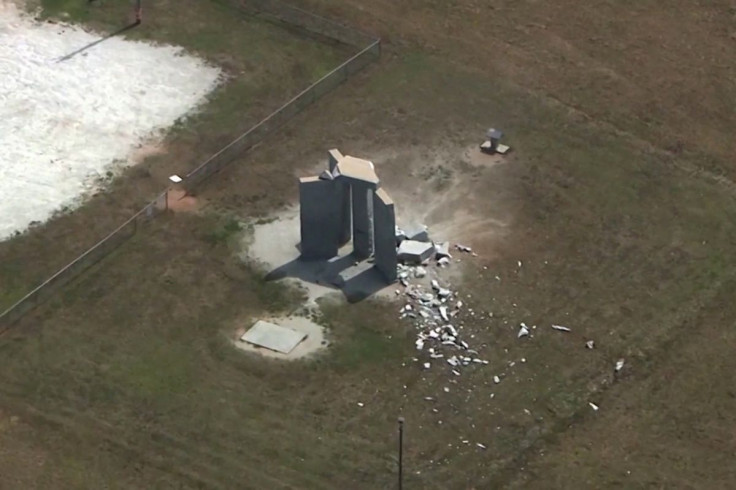Explosion Rocks Georgia Guidestones, Dubbed 'America's Stonehenge'

A peculiar granite monument that some have dubbed "America's Stonehenge" but a conservative politician condemned as "Satanic" was torn down on Wednesday by authorities in rural Georgia hours after it was heavily damaged in a bombing by vandals.
Investigators from several law enforcement agencies converged on the site 100 miles (161 km) east of Atlanta seeking clues to the pre-dawn explosion that blew a portion of the 42-year-old monument, called the Georgia Guidestones, to pieces.
The Georgia Bureau of Investigation (GBI) later posted on its official Twitter feed a video clip of the blast caught on surveillance camera and separate footage of a car speeding away from the scene.
It said the remainder of the structure was deliberately demolished later in the day "for safety reasons," with a photo showing the entire monument reduced to rubble. The initial damage was attributed to "unknown individuals" who "detonated an explosive device" at the site.
Before it was vandalized, the 19-foot-tall monument consisted of one upright slab at the center of four larger tablets arranged around it, with a large rectangular capstone placed atop the others.
The collection of gray monoliths was erected in 1980 in the middle of a large field near the town of Elberton, Georgia, off Highway 77, and was listed as a tourist attraction by the state's travel site and the Elbert County Chamber of Commerce.
The slabs were engraved with an enigmatic message in 12 languages calling for the preservation of humankind by limiting the world's population to fewer than a half-billion people to live "in perpetual balance with nature," according to official translations of the text.
The Guidestones also functioned as an astronomical calendar, arranged to let sunlight shine through a narrow hole in the structure at noon every day to illuminate engraved dates.
But the monument drew occasional controversy from some tying its message to far-right conspiracies or religious blasphemy.
Prominent among them was former Georgia gubernatorial candidate Kandiss Taylor, a third-place finisher in the May 24 Republican primary, who made removal of the monument part of her campaign platform, a stance spoofed by television comedian John Oliver.
Following news of the Guidestones' bombing on Wednesday, Taylor suggested on Twitter that the monument's demise was an act of divine intervention.
"God is God all by Himself. He can do ANYTHING He wants to do. That includes striking down Satanic Guidestones," she tweeted.
Taylor later released a video insisting she would never support vandalism and that "anyone who goes on private or public property to destroy anything illegally should be arrested."
No law enforcement officials have suggested that Kandiss was involved in the Guidestones bombing.
The precise origins of the ill-fated roadside attraction remain murky. It was built by a local granite finishing company at the behest of a mysterious benefactor who commissioned the work under the pseudonym of Robert C. Christian.
The Elberton Granite Association, which had maintained and preserved the stones, put the cost of replacing them at hundreds of thousands of dollars, according to local media.
Official descriptions say the monument has become known as America's Stonehenge. But the site paled in age and grandeur to the original Stonehenge, a prehistoric landmark in Wiltshire, England, believed to date to as early as 3000 BC.
© Copyright Thomson Reuters 2024. All rights reserved.





















